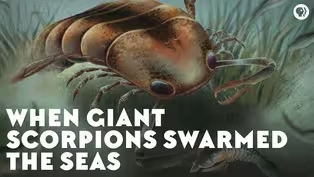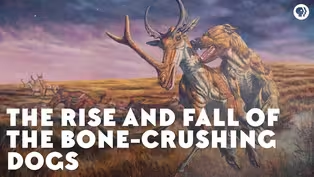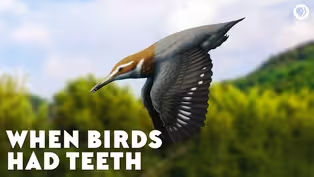
When Insects First Flew
Season 1 Episode 49 | 8m 38sVideo has Closed Captions
Insects were the first animals to fly. Scientists are still working on how it happened.
Insects were the first animals to ever develop the ability to fly, and, arguably, they did it the best. But this development was so unusual that scientists are still working on, and arguing about, how and when insect wings first came about.
Problems playing video? | Closed Captioning Feedback
Problems playing video? | Closed Captioning Feedback

When Insects First Flew
Season 1 Episode 49 | 8m 38sVideo has Closed Captions
Insects were the first animals to ever develop the ability to fly, and, arguably, they did it the best. But this development was so unusual that scientists are still working on, and arguing about, how and when insect wings first came about.
Problems playing video? | Closed Captioning Feedback
How to Watch Eons
Eons is available to stream on pbs.org and the free PBS App, available on iPhone, Apple TV, Android TV, Android smartphones, Amazon Fire TV, Amazon Fire Tablet, Roku, Samsung Smart TV, and Vizio.

Welcome to Eons!
Join hosts Michelle Barboza-Ramirez, Kallie Moore, and Blake de Pastino as they take you on a journey through the history of life on Earth. From the dawn of life in the Archaean Eon through the Mesozoic Era — the so-called “Age of Dinosaurs” -- right up to the end of the most recent Ice Age.Providing Support for PBS.org
Learn Moreabout PBS online sponsorshipMore from This Collection
Ancient Fauna, Flora & Fungi
When Giant Scorpions Swarmed the Seas
Video has Closed Captions
Sea scorpions thrived for 200 million years, coming in a wide variety of shapes and sizes. (11m 38s)
Video has Closed Captions
A look at when Temnospondyls Amphibians existed for 210 million years (9m 51s)
Life, Sex & Death Among the Dire Wolves
Video has Closed Captions
Dire wolves were real! Their remains taught us a lot about how they lived. (9m 15s)
The Rise and Fall of the Bone-Crushing Dogs
Video has Closed Captions
What happened to the biggest dogs that ever lived? (8m 29s)
How Horses Took Over North America (Twice)
Video has Closed Captions
Horses vanished from North America for 10,000 years until a mammal brought them back. (9m 8s)
Video has Closed Captions
How did Archaeopteryx relate to today’s birds? Its teeth provide a major clue. (11m 29s)
Video has Closed Captions
420 million years ago, some fish wore armor – and it may have served a surprising purpose. (9m 37s)
Video has Closed Captions
Before a group of fish could live on dry land, they acquired the ability to breathe air. (8m 40s)
Why Triassic Animals Were Just the Weirdest
Video has Closed Captions
Why the Triassic was full of creatures that look a lot like other, more modern species. (9m 7s)
Video has Closed Captions
Ancestors of cephalopods all had shells until it proved to be their biggest weakness. (8m 5s)
Video has Closed Captions
Where did turtles come from? And how did the they get their shells? (8m 29s)
Providing Support for PBS.org
Learn Moreabout PBS online sponsorshipVertebrates get a lot of credit for being able to fly.
Birds, bats, and pterosaurs all took to the skies, with the help of modified forelimbs that served as wings.
But spare a thought for the insects, who evolved flight only once, and never looked back.
They were the first animals to ever develop the ability to fly, and, arguably, they did it the best.
That's because evolution usually works with what it has; new body structures don't crop up very often.
But in the case of insects, they didn't use modified limbs to fly.
Their wings were a brand new innovation in their physiology.
And in fact, this development was so unusual that scientists are still working on, and arguing about, how and when insect wings first came about.
So, I'll tell you up front: There's a lot we don't know.
But one thing that experts do agree on is that the ability to fly was something totally, completely new when insects acquired it.
And it allowed them to take over the world.
I'd like to show you the very first known insect, as well as the first flying insect, but I'm afraid I'd start a brawl among the paleontologists who study these things.
Because, the fact is, almost every early insect fossil has been disputed, or has been accused of being a different type of arthropod, or even an artifact of modern contamination.
One contender for the first insect ever is known as Rhyniognatha hirsti, discovered almost a hundred years ago in Scotland.
This little guy is more than 400 million years old, and it looks like just an ink blot to somebody who doesn't know what they're looking at.
In 2004, some American researchers interpreted Rhyniognatha as a flying insect -- even though the fossil didn't have any wings.
Instead, they looked at its mouthparts and decided they resembled those of a mayfly.
But this conclusion was challenged in 2017, by another team that used high-tech photography and decided that Rhyniognatha was more likely a kind of centipede, not an insect at all.
Much less a flying one.
If Rhyniognatha isn't an insect, then the contender that everyone seems to accept as the earliest known insect are some very fragmentary pieces of exoskeleton found in Gilboa, New York.
These little fragments are about 380 million years old, and are thought to have belonged to insects from the order Archaeognatha, a group that includes some of the most primitive insects still alive today.
Now, the earliest fossil evidence of a flying insect seems to be the mayfly-like critter called Delitzschala bitterfeldensis from 325 million years ago.
And, you'll notice there's quite a big gap between the probably-earliest-insect and the appearance of winged insects in the fossil record.
Paleontologists have noticed this, too, where fossils of insects are few and far between.
They call it the Hexapoda Gap.
For roughly 65 million years, basically the second half of the Devonian Period and the first half of the Carboniferous, insects existed and continued to evolve, but for some reason, they weren't preserved very often in the fossil record.
This gap complicates the issue of when flying insects first appeared.
Right now, there are two main, competing theories.
One theory holds that, if Rhyniognatha was a flying insect, that would mean that the pterygotes -- the taxonomic group that includes flying insects -- first came about in the early Devonian, say, more than 400 million years ago.
But, they didn't become very numerous or diverse, which would explain why they're not represented well for those 65 million years, until they suddenly exploded in diversity in the late Carboniferous.
The other theory assumes that Rhyniognatha was not a flying insect, so Delitzschala is the earliest one we know about, which appeared tens of millions of years later.
In this case, flying insects would have evolved before Delitzschala, but not as early as Rhyniognatha - - and we just don't know when, thanks to the gap.
And sure enough, there's some evidence to support both of these theories.
On one hand, molecular data for the origin of flying insects line up with the age of Rhyniognatha, suggesting it or something that lived during the same time might've been the first.
A big, ambitious study published in 2014 used genetic data to estimate the age of the entire insect class.
They sequenced DNA from 103 species of insects, representing every order known to science.
And then they used this massive amount of data to construct an insect tree of life, estimating when each group of insects diverged from their common ancestors.
Studies like this are based on the idea of the molecular clock, which hypothesizes that mutations build up at a certain rate.
When that rate of change is compared to what we see in the fossil record, it can be used to estimate when a certain group first evolved.
And the results suggested that flying insects could have originated 406 million years ago, in the early Devonian -- and that the common ancestor of all insects lived a whopping 440 million years ago, in the Silurian period.
So, the study didn't weigh in on whether Rhyniognatha, specifically, was a flying insect, but it said the timing makes it at least plausible.
Now, the competing theory relies more on hard fossil evidence to determine when insects first took flight.
Of course, insects are small and fragile, so they don't make for great fossils.
But insect wings fossilize pretty well, and some scientists argue that when we start seeing wings 325 million years ago, like in Delitzschala, it's safe to conclude that the wings evolved not long before.
But one thing that most paleontologists agree on -- and yes they do agree on something!
- - is that, when wings finally appeared, they changed everything.
The ability to fly allowed insects to escape predators and forage for food in ways, and in places, that no other creature could before.
Winged insects represent the vast majority of insects today, and that diversity may be the result of the success that the power of flight gave them.
But because wings appear to show up so suddenly in the fossil record, we don't really know how this evolutionary breakthrough came about.
There aren't a lot of transitional fossils to work with.
So, how did wings evolve in the first place?
For a long time, it's been an open question as to whether insect wings evolved as brand new structures, or were adapted from some pre-existing body part -- the way bird wings evolved from forelimbs.
Some genetic and fossil evidence supports the idea that wings started out as gill structures.
Many species of aquatic insects have flat extensions on the thorax and abdomen, when they're in their nymph phase.
They sometimes have patterns that look like the veins of wings, AND they can even flap!
But, while the gill origin theory has received a good deal of support, more scientists now seem to lean towards the wings being a brand new kind of structure.
In recent years, scientists have hotly debated whether the body tissue came from the top of the insect, known as the notum, or the side of the body, known as the pleura.
And again, there are good arguments on both sides.
The notum would have provided the stiff, rigid structure that wings need to create lift and support the insect in the air.
But having them develop on the sides of the body would have offered maneuverability.
And in fact, research has found that the genes that create moveable joints in insects activate on the sides of the body.
Since an insect's legs develop from its sides, and they obviously move, then possibly those same genes or similar ones would be needed to give the wings their ability to flap.
A study of ancient insects conducted in 2017 said: Why not both?
It provided support for the hypothesis that wings could have come from both the top and the sides.
This research looked at insects from the late Carboniferous, like Idoptilus.
In its nymphal form, it had two pairs of wing-like structures, plus a third pair of stiff lobes extending from the sides that might have been used for thermoregulation.
The authors believe these lobes represent what the earliest form of insect wings were like.
Most of the structure came from the top, providing rigidity, while the flexible wing joint came from the side of the body.
And even though these young insects probably couldn't fly, those lobes could have been used to glide.
So it could be that the ancestor of all pterygotes had three pairs of lobes, too, which could have been used to glide from the tops of, say, scale trees.
And then, those lobes were adapted for use as wings, as insects developed the musculature needed for powered flight.
In the end, we don't know for sure when insects first flew.
Or where their wings even came from!
For now, the origins of insect flight remain one of paleontology's great mysteries.
But we do know that the evolution of flight played a key role in helping insects thrive as they do today, living on every continent and in nearly every ecosystem, as one of natural history's greatest success stories.


- Science and Nature

A documentary series capturing the resilient work of female land stewards across the United States.












Support for PBS provided by:












